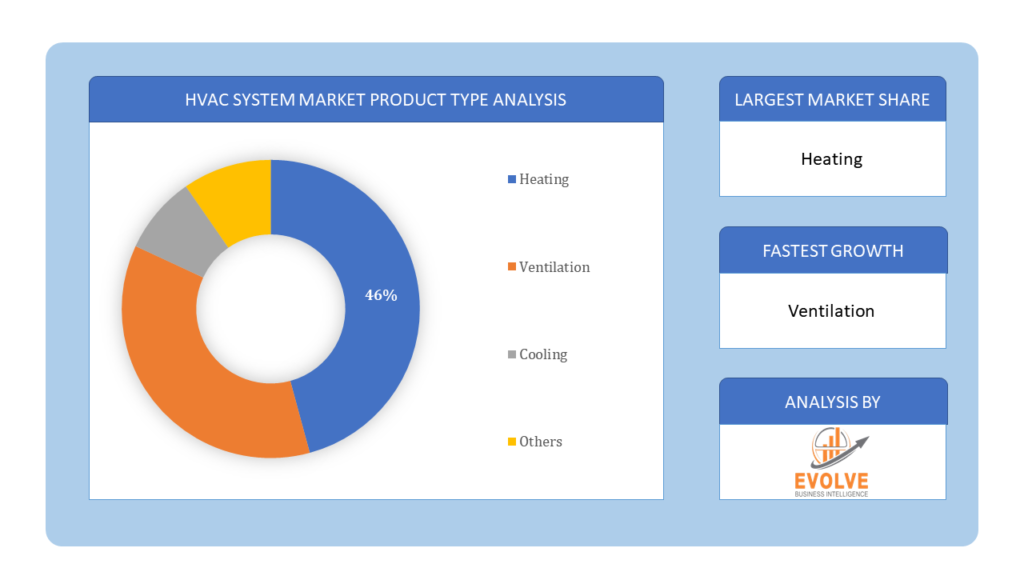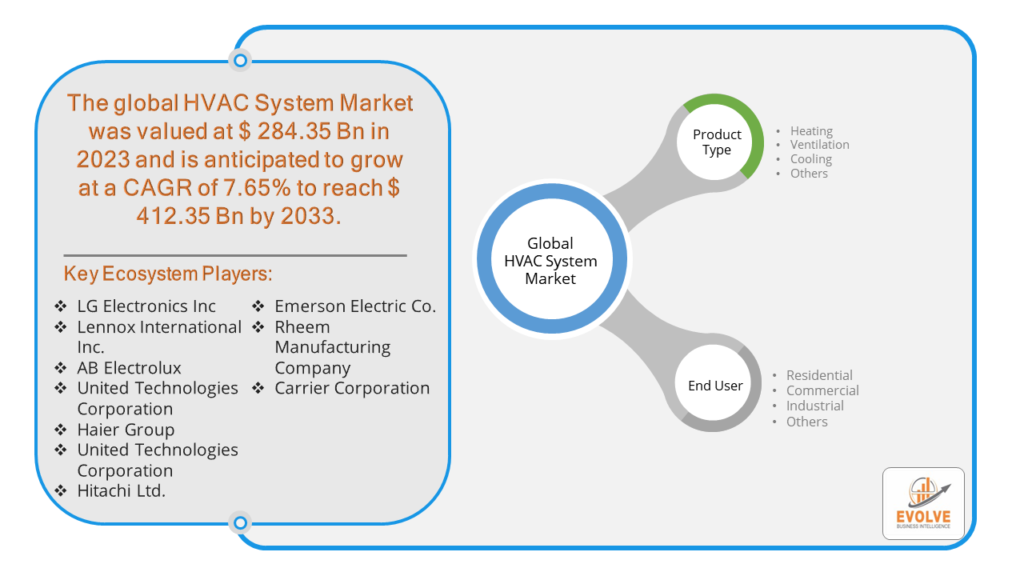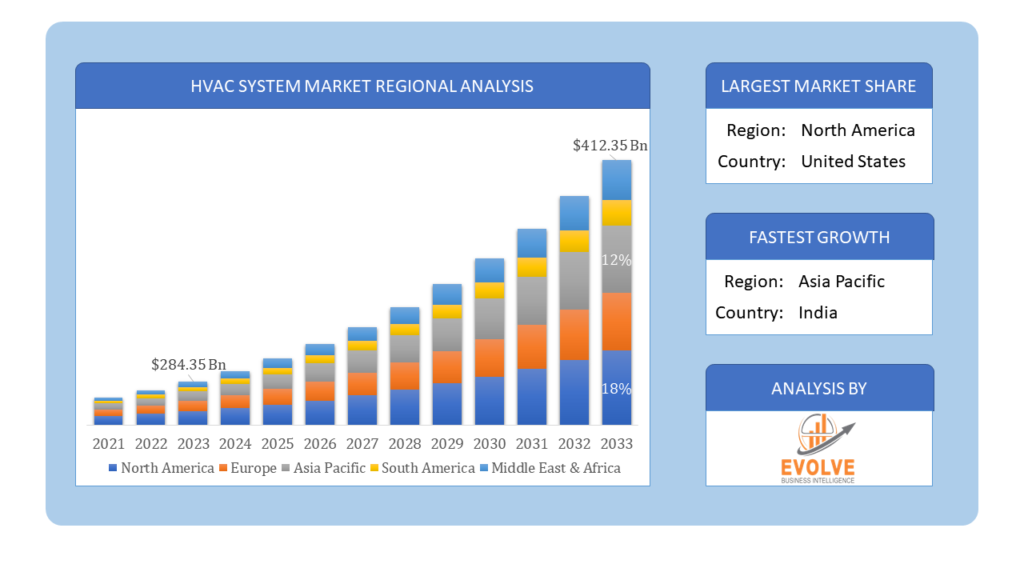HVAC system Market Analysis and Global Forecast 2023-2033
$ 1,390.00 – $ 5,520.00Price range: $ 1,390.00 through $ 5,520.00
HVAC system Market Research Report: Information By Product Type (Heating, Ventilation, Cooling, Others), By End-User (Residential, Commercial, Industrial, Others), and by Region — Forecast till 2033
Page: 165
HVAC system Market Overview
The HVAC system Market Size is expected to reach USD 412.35 Billion by 2033. The HVAC system Market industry size accounted for USD 284.35 Billion in 2023 and is expected to expand at a compound annual growth rate (CAGR) of 7.65% from 2023 to 2033. The HVAC (Heating, Ventilation, and Air Conditioning) system market refers to the industry involved in the production, distribution, and sale of systems and components designed to regulate indoor environmental conditions. This market encompasses a wide range of products and services aimed at ensuring comfort, air quality, and energy efficiency in residential, commercial, and industrial settings.
The HVAC (Heating, Ventilation, and Air Conditioning) system market factors are driving growth like Increasing demand for energy-efficient and sustainable buildings and Rising need for comfortable indoor air quality and climate control across different property types.
Global HVAC system Market Synopsis
The COVID-19 pandemic had a significant impact on the HVAC (Heating, Ventilation, and Air Conditioning) system market. There has been a surge in demand for advanced air filtration systems, air purifiers, and HVAC units equipped with HEPA filters and UV-C light technology to reduce airborne contaminants and improve indoor air quality. Increased emphasis on proper ventilation in buildings to reduce the spread of the virus. This has led to a rise in retrofitting and upgrading existing HVAC systems to enhance airflow and ensure adequate ventilation. Increased investment in HVAC systems in commercial buildings, hospitals, and other public spaces to ensure safe environments for employees and visitors. Rise in demand for HVAC solutions in healthcare facilities for better infection control and air quality management. Increased awareness of indoor air quality among homeowners, leading to higher demand for residential HVAC upgrades and installations.
HVAC system Market Dynamics
The major factors that have impacted the growth of HVAC system Market are as follows:
Drivers:
Ø Technological Advancements
Integration of smart technologies, such as IoT, AI, and automation, enhances the functionality and efficiency of HVAC systems, driving market growth. Development of advanced controls and sensors for better system management, energy savings, and improved indoor air quality. Increasing awareness of the health impacts of poor indoor air quality drives demand for HVAC systems with advanced filtration and purification technologies. Changing climate patterns and extreme weather conditions increase the need for reliable and efficient heating and cooling solutions. Seasonal variations and temperature extremes drive the demand for HVAC systems to maintain comfortable indoor environments.
Restraint:
- Perception of High Initial Costs
The high initial cost of purchasing and installing advanced HVAC systems can be a significant barrier for consumers and businesses, particularly in developing regions. Integrating smart technologies and energy-efficient components often increases the overall cost, making it less accessible for price-sensitive customers. HVAC systems require regular maintenance to ensure optimal performance, which can be costly and time-consuming for owners. The ongoing operational costs, including energy consumption and repairs, can be a financial burden, especially for older or less efficient systems.
Opportunity:
⮚ Growing demand for Energy Efficiency and Sustainability
Increasing awareness and government incentives for energy-efficient HVAC systems present a significant opportunity for manufacturers to develop and market high-efficiency products. Growing adoption of renewable energy sources, such as solar and geothermal energy, provides opportunities to integrate HVAC systems with these technologies to reduce carbon footprints. Increasing adoption of smart home technologies creates opportunities for HVAC systems that integrate with connected home platforms. Utilization of data analytics and predictive maintenance technologies to optimize HVAC system performance and reduce downtime.
HVAC system Market Segment Overview
By Product Type
 Based on Product Type, the market is segmented based on Heating, Ventilation, Cooling and Others. The Cooling segment dominant the market. Cooling equipment in an HVAC system plays a crucial role in maintaining indoor comfort by removing heat and humidity from the air. The primary function of cooling equipment is to lower the temperature of indoor spaces during hot weather.
Based on Product Type, the market is segmented based on Heating, Ventilation, Cooling and Others. The Cooling segment dominant the market. Cooling equipment in an HVAC system plays a crucial role in maintaining indoor comfort by removing heat and humidity from the air. The primary function of cooling equipment is to lower the temperature of indoor spaces during hot weather.
By End User
Based on End Users, the market segment has been divided into the Residential, Commercial, Industrial and Others. The Residential segment dominant the market. An increase in multi-family and individual homeowners is creating avenues for the residential HVAC segment. Rapid urbanization, rising disposable incomes, and growing awareness of energy efficiency contribute to the increased demand for comfortable living environments. These factors are anticipated to fuel the adoption of HVAC systems, such as air-conditioning, air filtration, air purifiers, and dehumidifiers, over the forecast period. Commercial HVAC systems are bigger and more complex than residential HVAC units.
Global HVAC system Market Regional Analysis
Based on region, the global HVAC system Market has been divided into North America, Europe, Asia-Pacific, the Middle East & Africa, and Latin America. North America is projected to dominate the use of the HVAC system Market followed by the Asia-Pacific and Europe regions.
 HVAC system North America Market
HVAC system North America Market
North America holds a dominant position in the HVAC system Market. United States and Canada is mature market with high demand for energy-efficient HVAC systems. Strong emphasis on sustainability and compliance with energy efficiency standards (e.g., ENERGY STAR). Growing adoption of smart HVAC technologies and air quality solutions and replacement and retrofitting of aging HVAC infrastructure in residential and commercial buildings.
HVAC system Asia-Pacific Market
The Asia-Pacific region has indeed emerged as the fastest-growing market for the HVAC system Market industry. The booming construction industry in countries like China and India, coupled with rising disposable incomes and a growing middle class, is driving the demand for HVAC systems in both homes and businesses. The hot and humid climate in many APAC countries further fuels the need for efficient cooling solutions.
Competitive Landscape
The global HVAC system Market is highly competitive, with numerous players offering a wide range of software solutions. The competitive landscape is characterized by the presence of established companies, as well as emerging startups and niche players. To increase their market position and attract a wide consumer base, the businesses are employing various strategies, such as product launches, and strategic alliances.
Prominent Players:
- LG Electronics Inc
- Lennox International Inc.
- AB Electrolux
- United Technologies Corporation
- Haier Group
- United Technologies Corporation
- Hitachi Ltd.
- Emerson Electric Co.
- Rheem Manufacturing Company
- Carrier Corporation
Key Development
In June 2023, Mitsubishi Electric Trane HVAC US LLC (METUS), a leading supplier of all-climate Ductless and Ducted Mini-split and Variable Refrigerant Flow (VRF) heat-pump and air-conditioning systems, announced the introduction of Hybrid VRF®, a cutting-edge two-pipe VRF zoning system designed to use water instead of refrigerant in indoor spaces.
Scope of the Report
Global HVAC system Market, by Product Type
- Heating
- Ventilation
- Cooling
- Others
Global HVAC system Market, by End User
- Residential
- Commercial
- Industrial
- Others
Global HVAC system Market, by Region
- North America
- US
- Canada
- Mexico
- Europe
- UK
- Germany
- France
- Italy
- Spain
- Benelux
- Nordic
- Rest of Europe
- Asia Pacific
- China
- Japan
- South Korea
- Indonesia
- Austalia
- Malaysia
- India
- Rest of Asia Pacific
- South America
- Brazil
- Argentina
- Rest of South America
- Middle East & Africa
- Saudi Arabia
- UAE
- Egypt
- South Africa
- Rest of Middle East & Africa
| Parameters | Indicators |
|---|---|
| Market Size | 2033: $412.35 Billion/strong> |
| CAGR | 7.65% CAGR (2023-2033) |
| Base year | 2022 |
| Forecast Period | 2023-2033 |
| Historical Data | 2021 |
| Report Coverage | Revenue Forecast, Competitive Landscape, Growth Factors, and Trends |
| Key Segmentations | Product Type, End User |
| Geographies Covered | North America, Europe, Asia-Pacific, Latin America, Middle East, Africa |
| Key Vendors | LG Electronics Inc, Lennox International Inc., AB Electrolux, United Technologies Corporation, Haier Group, United Technologies Corporation, Hitachi Ltd., Emerson Electric Co., Rheem Manufacturing Company and Carrier Corporation. |
| Key Market Opportunities | • The growing demand for Energy Efficiency and Sustainability • Digital Transformation and Connectivity |
| Key Market Drivers | • Technological Advancements • Climate Change and Weather Extremes |
REPORT CONTENT BRIEF:
- High-level analysis of the current and future HVAC system Market trends and opportunities
- Detailed analysis of current market drivers, restraining factors, and opportunities in the future
- HVAC system Market historical market size for the year 2021, and forecast from 2023 to 2033
- HVAC system Market share analysis at each product level
- Competitor analysis with detailed insight into its product segment, Government & Defense strength, and strategies adopted.
- Identifies key strategies adopted including product launches and developments, mergers and acquisitions, joint ventures, collaborations, and partnerships as well as funding taken and investment done, among others.
- To identify and understand the various factors involved in the global HVAC system Market affected by the pandemic
- To provide a detailed insight into the major companies operating in the market. The profiling will include the Government & Defense health of the company’s past 2-3 years with segmental and regional revenue breakup, product offering, recent developments, SWOT analysis, and key strategies.
Press Release

Global Pharmaceutical Manufacturing Market to Reach $1.38 Trillion by 2035 with 7.35% CAGR, New Research Shows

The Global Mammography Market Is Estimated To Record a CAGR of Around 10.29% During The Forecast Period

Glue Stick Market to Reach USD 2.35 Billion by 2034

Podiatry Service Market to Reach USD 11.88 Billion by 2034

Microfluidics Technology Market to Reach USD 32.58 Billion by 2034

Ferric Chloride Market to Reach USD 10.65 Billion by 2034

Family Practice EMR Software Market to Reach USD 21.52 Billion by 2034

Electric Hairbrush Market to Reach USD 15.95 Billion by 2034

Daily Bamboo Products Market to Reach USD 143.52 Billion by 2034

Cross-border E-commerce Logistics Market to Reach USD 112.65 Billion by 2034
Frequently Asked Questions (FAQ)
1.What is the study period of this market?
- The study period of the global HVAC system Market is 2021- 2033
2.What is the growth rate of the global HVAC system Market?
- The global HVAC system Market is growing at a CAGR of 7.65% over the next 10 years
3.Which region has the highest growth rate in the market of HVAC system Market?
- Asia Pacific is expected to register the highest CAGR during 2023-2033
4.Which region has the largest share of the global HVAC system Market?
- North America holds the largest share in 2022
5.Who are the key players in the global HVAC system Market?
LG Electronics Inc, Lennox International Inc., AB Electrolux, United Technologies Corporation, Haier Group, United Technologies Corporation, Hitachi Ltd., Emerson Electric Co., Rheem Manufacturing Company and Carrier Corporation. are the major companies operating in the market
6.Do you offer Post Sale Support?
- Yes, we offer 16 hours of analyst support to solve the queries
7.Do you sell particular sections of a report?
Yes, we provide regional as well as country-level reports. Other than this we also provide a sectional report. Please get in contact with our sales representatives
Table of Content
Chapter 1. Executive Summary Chapter 2. Scope Of The Study 2.1. Market Definition 2.2. Scope Of The Study 2.2.1. Objectives of Report 2.2.2. Limitations 2.3. Market Structure Chapter 3. Evolve BI Methodology Chapter 4. Market Insights and Trends 4.1. Supply/ Value Chain Analysis 4.1.1. Raw End Users Providers 4.1.2. Manufacturing Process 4.1.3. Distributors/Retailers 4.1.4. End-Use Industry 4.2. Porter’s Five Forces Analysis 4.2.1. Threat Of New Entrants 4.2.2. Bargaining Power Of Buyers 4.2.3. Bargaining Power Of Suppliers 4.2.4. Threat Of Substitutes 4.2.5. Industry Rivalry 4.3. Impact Of COVID-19 on the HVAC system Market 4.3.1. Impact on Market Size 4.3.2. End-Use Industry Trend, Preferences, and Budget Impact 4.3.3. Regulatory Framework/Government Policies 4.3.4. Key Players' Strategy to Tackle Negative Impact 4.3.5. Opportunity Window 4.4. Technology Overview 12.28. Macro factor 4.6. Micro Factor 4.7. Demand Supply Gap Analysis of the HVAC system Market 4.8. Import Analysis of the HVAC system Market 4.9. Export Analysis of the HVAC system Market Chapter 5. Market Dynamics 5.1. Introduction 5.2. DROC Analysis 5.2.1. Drivers 5.2.2. Restraints 5.2.3. Opportunities 5.2.4. Challenges 5.3. Patent Analysis 5.4. Industry Roadmap 5.5. Parent/Peer Market Analysis Chapter 6. Global HVAC system Market, By Product Type 6.1. Introduction 6.2. Heating 6.3. Ventilation 6.4. Cooling 6.5. Others Chapter 7. Global HVAC system Market, By End User 7.1. Introduction 7.2. Residential 7.3. Commercial 7.4. Industrial 7.5. Others Chapter 8. Global HVAC system Market, By Region 8.1. Introduction 8.2. North America 8.2.1. Introduction 8.2.2. Driving Factors, Opportunity Analyzed, and Key Trends 8.2.3. Market Size and Forecast, By Country, 2023-2033 8.2.4. Market Size and Forecast, By Product Type, 2023-2033 8.2.5. Market Size and Forecast, By End User, 2023-2033 8.2.6. US 8.2.6.1. Introduction 8.2.6.2. Driving Factors, Opportunity Analyzed, and Key Trends 8.2.6.3. Market Size and Forecast, By Product Type, 2023-2033 8.2.6.4. Market Size and Forecast, By End User, 2023-2033 8.2.7. Canada 8.2.7.1. Introduction 8.2.7.2. Driving Factors, Opportunity Analyzed, and Key Trends 8.2.7.4. Market Size and Forecast, By Product Type, 2023-2033 8.2.7.5. Market Size and Forecast, By End User, 2023-2033 8.3. Europe 8.3.1. Introduction 8.3.2. Driving Factors, Opportunity Analyzed, and Key Trends 8.3.3. Market Size and Forecast, By Country, 2023-2033 8.3.4. Market Size and Forecast, By Product Type, 2023-2033 8.3.5. Market Size and Forecast, By End User, 2023-2033 8.3.6. Germany 8.3.6.1. Introduction 8.3.6.2. Driving Factors, Opportunity Analyzed, and Key Trends 8.3.6.3. Market Size and Forecast, By Product Type, 2023-2033 8.3.6.4. Market Size and Forecast, By End User, 2023-2033 8.3.7. France 8.3.7.1. Introduction 8.3.7.2. Driving Factors, Opportunity Analyzed, and Key Trends 8.3.7.3. Market Size and Forecast, By Product Type, 2023-2033 8.3.7.4. Market Size and Forecast, By End User, 2023-2033 8.3.8. UK 8.3.8.1. Introduction 8.3.8.2. Driving Factors, Opportunity Analyzed, and Key Trends 8.3.8.3. Market Size and Forecast, By Product Type, 2023-2033 8.3.8.4. Market Size and Forecast, By End User, 2023-2033 8.3.9. Italy 8.3.9.1. Introduction 8.3.9.2. Driving Factors, Opportunity Analyzed, and Key Trends 8.3.9.3. Market Size and Forecast, By Product Type, 2023-2033 8.3.9.4. Market Size and Forecast, By End User, 2023-2033 8.3.11. Rest Of Europe 8.3.11.1. Introduction 8.3.11.2. Driving Factors, Opportunity Analyzed, and Key Trends 8.3.11.3. Market Size and Forecast, By Product Type, 2023-2033 8.3.11.4. Market Size and Forecast, By End User, 2023-2033 8.4. Asia-Pacific 8.4.1. Introduction 8.4.2. Driving Factors, Opportunity Analyzed, and Key Trends 8.4.3. Market Size and Forecast, By Country, 2023-2033 8.4.4. Market Size and Forecast, By Product Type, 2023-2033 8.12.28. Market Size and Forecast, By End User, 2023-2033 8.4.6. China 8.4.6.1. Introduction 8.4.6.2. Driving Factors, Opportunity Analyzed, and Key Trends 8.4.6.3. Market Size and Forecast, By Product Type, 2023-2033 8.4.6.4. Market Size and Forecast, By End User, 2023-2033 8.4.7. India 8.4.7.1. Introduction 8.4.7.2. Driving Factors, Opportunity Analyzed, and Key Trends 8.4.7.3. Market Size and Forecast, By Product Type, 2023-2033 8.4.7.4. Market Size and Forecast, By End User, 2023-2033 8.4.8. Japan 8.4.8.1. Introduction 8.4.8.2. Driving Factors, Opportunity Analyzed, and Key Trends 8.4.8.3. Market Size and Forecast, By Product Type, 2023-2033 8.4.8.4. Market Size and Forecast, By End User, 2023-2033 8.4.9. South Korea 8.4.9.1. Introduction 8.4.9.2. Driving Factors, Opportunity Analyzed, and Key Trends 8.4.9.3. Market Size and Forecast, By Product Type, 2023-2033 8.4.9.4. Market Size and Forecast, By End User, 2023-2033 8.4.10. Rest Of Asia-Pacific 8.4.10.1. Introduction 8.4.10.2. Driving Factors, Opportunity Analyzed, and Key Trends 8.4.10.3. Market Size and Forecast, By Product Type, 2023-2033 8.4.10.4. Market Size and Forecast, By End User, 2023-2033 8.5. Rest Of The World (RoW) 8.5.1. Introduction 8.5.2. Driving Factors, Opportunity Analyzed, and Key Trends 8.5.3. Market Size and Forecast, By Product Type, 2023-2033 8.5.4. Market Size and Forecast, By End User, 2023-2033 Chapter 9. Company Landscape 9.1. Introduction 9.2. Vendor Share Analysis 9.3. Key Development Analysis 9.4. Competitor Dashboard Chapter 10. Company Profiles 10.1. LG Electronics Inc 10.1.1. Business Overview 10.1.2. Government & Defense Analysis 10.1.2.1. Government & Defense – Existing/Funding 10.1.3. Product Portfolio 10.1.4. Recent Development and Strategies Adopted 10.1.5. SWOT Analysis 10.2. Lennox International Inc. 10.2.1. Business Overview 10.2.2. Government & Defense Analysis 10.2.2.1. Government & Defense – Existing/Funding 10.2.3. Product Portfolio 10.2.4. Recent Development and Strategies Adopted 10.2.5. SWOT Analysis 10.3. AB Electrolux 10.3.1. Business Overview 10.3.2. Government & Defense Analysis 10.3.2.1. Government & Defense – Existing/Funding 10.3.3. Product Portfolio 10.3.4. Recent Development and Strategies Adopted 10.3.5. SWOT Analysis 10.4. United Technologies Corporation 10.4.1. Business Overview 10.4.2. Government & Defense Analysis 10.4.2.1. Government & Defense – Existing/Funding 10.4.3. Product Portfolio 10.4.4. Recent Development and Strategies Adopted 10.12.28. SWOT Analysis 10.5. Haier Group 10.5.1. Business Overview 10.5.2. Government & Defense Analysis 10.5.2.1. Government & Defense – Existing/Funding 10.5.3. Product Portfolio 10.5.4. Recent Development and Strategies Adopted 10.5.5. SWOT Analysis 10.6. United Technologies Corporation 10.6.1. Business Overview 10.6.2. Government & Defense Analysis 10.6.2.1. Government & Defense – Existing/Funding 10.6.3. Product Portfolio 10.6.4. Recent Development and Strategies Adopted 10.6.5. SWOT Analysis 10.7. Hitachi Ltd. 10.7.1. Business Overview 10.7.2. Government & Defense Analysis 10.7.2.1. Government & Defense – Existing/Funding 10.7.3. Product Portfolio 10.7.4. Recent Development and Strategies Adopted 10.7.5. SWOT Analysis 10.8 Emerson Electric Co. 10.8.1. Business Overview 10.8.2. Government & Defense Analysis 10.8.2.1. Government & Defense – Existing/Funding 10.8.3. Product Portfolio 10.8.4. Recent Development and Strategies Adopted 10.8.5. SWOT Analysis 10.9 Rheem Manufacturing Company 10.9.1. Business Overview 10.9.2. Government & Defense Analysis 10.9.2.1. Government & Defense – Existing/Funding 10.9.3. Product Portfolio 10.9.4. Recent Development and Strategies Adopted 10.9.5. SWOT Analysis 10.10. Carrier Corporation 10.10.1. Business Overview 10.10.2. Government & Defense Analysis 10.10.2.1. Government & Defense – Existing/Funding 10.10.3. Product Portfolio 10.10.4. Recent Development and Strategies Adopted 10.10.5. SWOT Analysis
Connect to Analyst
Research Methodology







